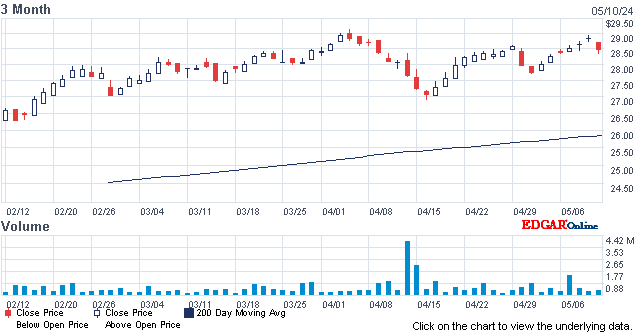Dow jumped 128, advancers over decliners less than 3-2 & NAZ went up 29. The MLP index fell 3 to under 431 & the REIT index lost 3+ to the 315s. Junk bond funds were mixed & Treasuries retrated. Oil pulled back after recent gains, but remains near yearly highs, & gold was off a tad.
AMJ (Alerian MLP Index tracking fund)

Service industries expanded in May at the slowest pace in 13 months as orders eased, signaling tempered improvement in the biggest part of the US economy. The Institute for Supply Management’s non-manufacturing index, which includes an array of industries from real estate to dining, declined to 55.7 from 57.8 in Apr. Readings above 50 signal expansion & the May gauge was weaker than the 57 forecast. Limited growth in orders reflects an American consumer who has been saving the extra cash from low gasoline prices & rising employment rather than spending it. Stronger household demand would help invigorate growth at service providers that make up almost 90% of the economy. The ISM’s new orders gauge fell to 57.9 in May from 59.2 a month earlier & the index of backlogs slumped by 6 points to 48.5, the weakest reading since Dec 2013. An index of employment in service industries cooled to 55.3 in May from 56.7. The business activity measure dropped to 59.5 from the prior month’s 61.6. The figure parallels the ISM’s factory production gauge, which also cooled last month. The group perviously reported its manufacturing index expanded in May, with orders growing at the strongest pace in 5 months, as the economy began to emerge from a Q1 downturn. The pickup in bookings & strongest reading for order backlogs since Nov point to production gains that will probably help GDP bounce back after shrinking in Q1.
The US trade deficit narrowed more than forecast in Apr as imports receded, signaling merchandise flows were returning to normal following a port-related surge. The gap shrank by 19.2% to $40.9B from the prior month’s $50.6B that was the widest in more than 6 years, according to the Commerce Dept. The forecast called for a deficit of $44B. Purchases of foreign-made goods declined after the end of a labor dispute at West Coast ports caused them to jump in Mar. Trade may become less of a detriment to the world’s largest economy as a more stable dollar & strengthening markets in Europe underpin overseas demand for American-made goods. At the same time, crude-oil production will probably continue to limit imports after the US petroleum gap fell in Apr to the lowest level in 13 years. The Mar deficit was the largest since Oct 2008. It was initially reported as a $51.4B shortfall. Imports declined 3.3% to $230.8B, after jumping 6.5% in Mar when West Coast ports cleared backlogs following the end of a labor dispute. Purchases of foreign-made cellular phones & clothing were among those showing the biggest declines. The value of crude-oil imports was little changed at $11B compared with $10.5B in Mar. An increase in fuel exports allowed the trade deficit in petroleum products to shrink to $6.8B, the smallest since 2002. Excluding petroleum, the trade shortfall declined to $34.1B from $43.1B in Mar. In Apr, total exports increased 1% to $189.9B, the most this year, on increased shipments of aircraft & telecommunications equipment. After eliminating the influence of prices, which renders the numbers used to calculate GDP, the trade deficit shrank to $57.2B from $66.4B. The Apr reading was slightly smaller than the $57.6B average for Q1, indicating trade is so far having little effect on GDP. Figures released last week showed that for Q1, a surge in imports led the trade gap to widen more than previously projected by the gov which subtracted 1.9 percentage points from growth, the most since 1985.
The mish-mash of data was not all that favorable, but good enough for the traders to take the Dow higher. Breadth is very thin indicating there is limited enthusiasm for the numbers released. The reduction in the forecast for global growth from the OECD should be getting more attention & that is not encouraging. But traders are not worried & Dow is close to setting a new record. Dow is up 335 YTD.
Dow Jones Industrials
AMJ (Alerian MLP Index tracking fund)
| CLN15.NYM | ...Crude Oil Jul 15 | ...60.53 | (1.2%) |
| GC.CMX | ..........Gold Jun 15 | ....1,190.40 | (0.3%) |
The Organization for Economic Cooperation & Development cut its
global growth forecast, saying investment is lagging & risks including
a possible Greek default are hurting confidence. The world economy will expand 3.1% this year, down from the
3.7% predicted last Oct, the organization said. That compares with global growth of about 3.9% a year on average in the decade thru 2011. Last year, the
world economy grew 3.3%. With big companies reluctant to spend on plants, equipment &
technology as they did in past recoveries, lack of demand has also held
back employment, wages & consumption, the organization said. “We’re looking at a global economy that in some respects is
moderately good,” OECD Chief Economist Catherine Mann said. “There’s a lot of monetary accommodation, less fiscal drag;
most countries are enjoying reduction in oil prices. All of that is good
news and yet what we’re getting is growth” that isn’t matching the
average of the past 2 decades, she added. The Q1 contraction in the US accounted for the biggest
part of the 2015 forecast revision, though a softer expansion in China was also a factor. The OECD sees the US economy expanding 2% this year, down from 2.4% in 2014. As recently as Mar,
it predicted US growth of 3.1% in 2015. China will grow 6.8% this year, down from 7.4%. Growth in the euro area is improving, meaning the region is making a
positive contribution to growth this year, in contrast to the recent
past. Spurred by unprecedented stimulus by the ECB,
GDP in the 19-nation bloc is set to grow 1.4%
this year, up from 0.9% in 2014. “The euro zone is the bright picture,” Mann said. “It is enjoying the
effective policy action on the part of the ECB and the associated
currency depreciation, as well as low oil prices.” However, the region needs to resolve the impasse over Greece’s public finances, which continues to weigh on confidence. A
default by Greece or its exit from the euro area risks derailing the
recovery. “Failure to reach a satisfactory agreement between Greece and its
official creditors would intensify perceptions of re-denomination risk
and uncertainty,” the OECD said. The consequences would probably include
“financial fragmentation in the euro area, dampening real activity and
restarting negative feedback loops between the real economy, the banking
sector and public finances in vulnerable countries.”
OECD Cuts Global Growth Outlook
Service industries expanded in May at the slowest pace in 13 months as orders eased, signaling tempered improvement in the biggest part of the US economy. The Institute for Supply Management’s non-manufacturing index, which includes an array of industries from real estate to dining, declined to 55.7 from 57.8 in Apr. Readings above 50 signal expansion & the May gauge was weaker than the 57 forecast. Limited growth in orders reflects an American consumer who has been saving the extra cash from low gasoline prices & rising employment rather than spending it. Stronger household demand would help invigorate growth at service providers that make up almost 90% of the economy. The ISM’s new orders gauge fell to 57.9 in May from 59.2 a month earlier & the index of backlogs slumped by 6 points to 48.5, the weakest reading since Dec 2013. An index of employment in service industries cooled to 55.3 in May from 56.7. The business activity measure dropped to 59.5 from the prior month’s 61.6. The figure parallels the ISM’s factory production gauge, which also cooled last month. The group perviously reported its manufacturing index expanded in May, with orders growing at the strongest pace in 5 months, as the economy began to emerge from a Q1 downturn. The pickup in bookings & strongest reading for order backlogs since Nov point to production gains that will probably help GDP bounce back after shrinking in Q1.
Service Industries in U.S. Expand at Slowest Pace in a Year
The US trade deficit narrowed more than forecast in Apr as imports receded, signaling merchandise flows were returning to normal following a port-related surge. The gap shrank by 19.2% to $40.9B from the prior month’s $50.6B that was the widest in more than 6 years, according to the Commerce Dept. The forecast called for a deficit of $44B. Purchases of foreign-made goods declined after the end of a labor dispute at West Coast ports caused them to jump in Mar. Trade may become less of a detriment to the world’s largest economy as a more stable dollar & strengthening markets in Europe underpin overseas demand for American-made goods. At the same time, crude-oil production will probably continue to limit imports after the US petroleum gap fell in Apr to the lowest level in 13 years. The Mar deficit was the largest since Oct 2008. It was initially reported as a $51.4B shortfall. Imports declined 3.3% to $230.8B, after jumping 6.5% in Mar when West Coast ports cleared backlogs following the end of a labor dispute. Purchases of foreign-made cellular phones & clothing were among those showing the biggest declines. The value of crude-oil imports was little changed at $11B compared with $10.5B in Mar. An increase in fuel exports allowed the trade deficit in petroleum products to shrink to $6.8B, the smallest since 2002. Excluding petroleum, the trade shortfall declined to $34.1B from $43.1B in Mar. In Apr, total exports increased 1% to $189.9B, the most this year, on increased shipments of aircraft & telecommunications equipment. After eliminating the influence of prices, which renders the numbers used to calculate GDP, the trade deficit shrank to $57.2B from $66.4B. The Apr reading was slightly smaller than the $57.6B average for Q1, indicating trade is so far having little effect on GDP. Figures released last week showed that for Q1, a surge in imports led the trade gap to widen more than previously projected by the gov which subtracted 1.9 percentage points from growth, the most since 1985.
Trade Gap in U.S. Narrows More Than Forecast
The mish-mash of data was not all that favorable, but good enough for the traders to take the Dow higher. Breadth is very thin indicating there is limited enthusiasm for the numbers released. The reduction in the forecast for global growth from the OECD should be getting more attention & that is not encouraging. But traders are not worried & Dow is close to setting a new record. Dow is up 335 YTD.
Dow Jones Industrials















No comments:
Post a Comment